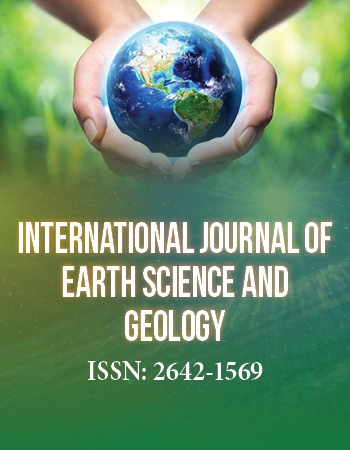Research Article
The Paleodepositional Environments in the Shendi Sub-Basin as part of the Atbara Basin, North Sudan
1Geological Research Authority of Sudan, Sudan
2Alneelain University, Sudan
*Corresponding author: A.T. Abdalrhman, Geological Research Authority of Sudan, Sudan, E-mail: ahmedtarig559@gmail.com
Received: January 05, 2022 Accepted: April 27, 2022 Published: May 16, 2022
Citation: Abdalrhman AT, Fagier TG, Abakar NH, Abdelrhman EM, Khairy AM, Ali KA, Khalifa I. The Paleodepositional Environments in the Shandi Sub-Basin as part of the Atbara Basin, North Sudan. Int J Earth Sci Geol. 2022; 4(1): 111-120. doi: 10.18689/ijeg-1000115
Copyright: © 2022 The Author(s). This work is licensed under a Creative Commons Attribution 4.0 International License, which permits unrestricted use, distribution, and reproduction in any medium, provided the original work is properly cited.
Abstract
This study describes the lithofacies diagnoses and the depositional environments of the Shendi sub-basin (a part of Atbara Basin) in North Sudan. Several full body fossils were observed in the study area such as trilobites, conulariids, Gyrophyllites and Archaeocyathids, in addition a number of trace fossils such as Rhizocorallium, and skolithos were reported. These fossils indicate deposition in a range of marine environments from intertidal to deep water. Furthermore, Herringbone cross-stratification is observed and it suggested a shallow water environment.
Two formations can be identified in the Shendi sub-basin; the lower formation was deposited in a range of shallow to deep marine environments of probable Lower Cambrian age while the upper formation of the ‘Nubian Sandstoneʼ was most likely deposited in fluvial environments of the Upper Cretaceous age. The lower formation is composed of four facies form bottom to top as; shale facies, carbonate facies, siltstone, fine sandstone facies, and chert facies. This study reveals the presence of the Archaeocyathids of Cambrian age, the oldest formation of the Paleozoic marine sedimentary rock ever found in Sudan.
Keywords: Shendi sub basin, Elbarda Abu telaih formation, Archaeocyatha, Lower Cambrian
1. Introduction
The study area occupies 2475 km2 land lies west of Shendi town on the western bank of the River Nile around Jebel Abu Telaih and Jebel Elbarda 150 km northeast of Khartoum (Fig 1), between latitudes (16° 40ʼ 00ʼʼ) (17° 10ʼ 00ʼʼ) and longitudes (33° 05ʼ 00ʼʼ) (33° 30ʼ 00ʼʼ). It is surrounded by the Pre-Cambrian units in Arab-Nubian Shield. Basins in this area were caused by rifting of the shield due to break up of Gondwanaland (Worrall, 1957, Whiteman, 1971). Paleozoic sediments are sometimes preserved in the deeper parts of the rifts basins.
Previous studies divided the main geological units in the study area into basement complex (Precambrian age), Nubian sandstone (Upper Cretaceous), Hudi chert (Oligocene), and Quaternary superficial deposits (Awad, 1994; Mukhtar, 1999) Basement crops out in the north around Mukabrab village and in the south in Um Shadida village (Kheirallah,1966).
Awad (1994) classified the Nubian sandstone into three sequences (lower, middle and upper), the lower is sandstone overlying the basement, and the middle part is ferruginous shale. The upper sequence is a sandstone that crops out in escarpments and in the inselbergs.
The previous study of the Shendi area concentrated on the Hudi chert and Upper Cretaceous Nubian Sandstone Formation (Mahjob, 1962; Omer, 1983). No marine fossils were recorded previously, but only fossils recorded in the area were freshwater gastropods in the Hudi chert. The present study on the Shendi area presents new findings reporting the presence of marine fossils and trace fossils in the Shendi subbasin.
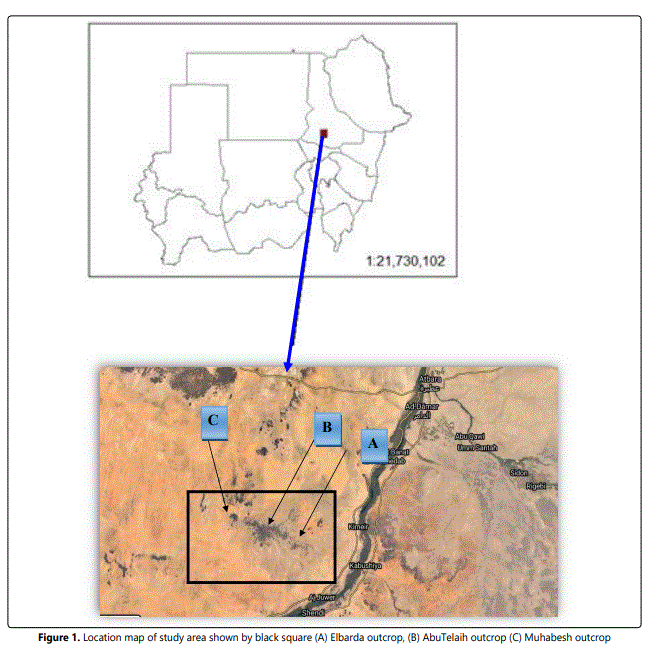
2. Geology of the Study Area
In the study area, the exposed Rocks form the features Jebel Elbarda, the Jebel AbuTelaih and the Jebel Muhabesh (Fig.2). According to lithology and fossils contained the present study divided Shendi sub-basin into two formations, the lower formation represented by the newly reported strata and refereed to the Elbarda AbuTelaih Formation, which will be described in the following paragraph, and the upper formation is the Nubian sandstone that has been described by previous studies.
2.1. The Elbarda AbuTelaih Formation
The Elbarda Abu Telaih Formation crops out in the lower parts of the Jebel Elbarda, Jebel AbuTelaih and Jebel Muhabesh. It consists of four members: a shale member, a carbonate member, a siltstone with fine sandstone member and a chert member.
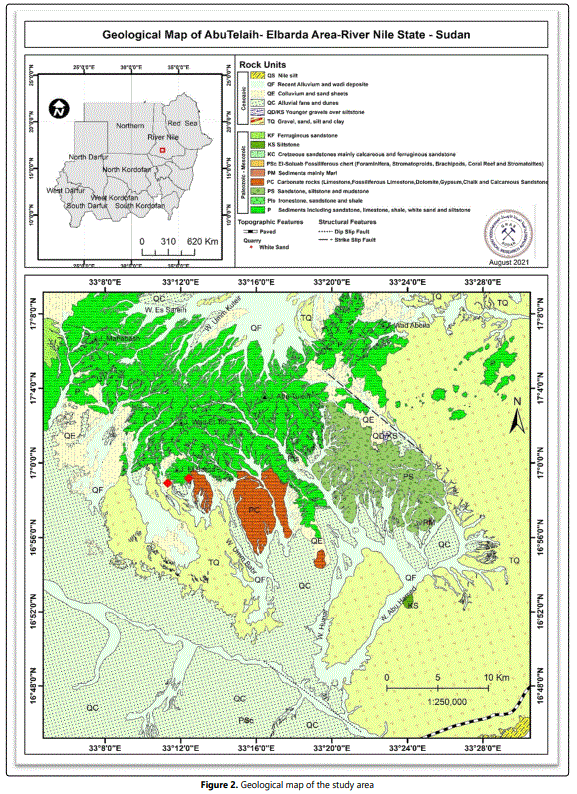
2.1.1. Shale member: The shale member crops out at the bases of Jebel AbuTelaih and Jebel Elbarda. There are two facies: black shale and gray shale. There are three sub-facies of black shale: black shale, brown to dark brown shale and phosphatic black shale. The thickness of black shale ranges from 15cm to 1.5m, thickness of brown to dark brown shale ranges from 40 cm to 1.5 m and the thickness of the phosphatic shale is 50 cm. These three facies are often lenses interbedded with the gray shale facies (Plate 1 and Figure 3).
The gray shale facies is regionally extensive across the study area and range in color from medium gray to dark gray. Eleven selected samples of gray shale were subjected to XRD analysis in RIMINIX laboratory in Morocco. The results show sodic and calcic bentonite that seem to be associated with high concentrations of calcite. The gray shale facies range in thickness from approximately 1.5m to 200m. (Plate 1 and Figure 4).
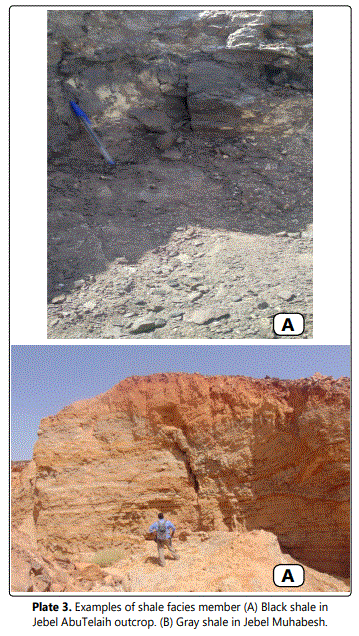
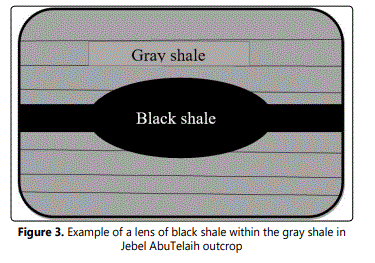
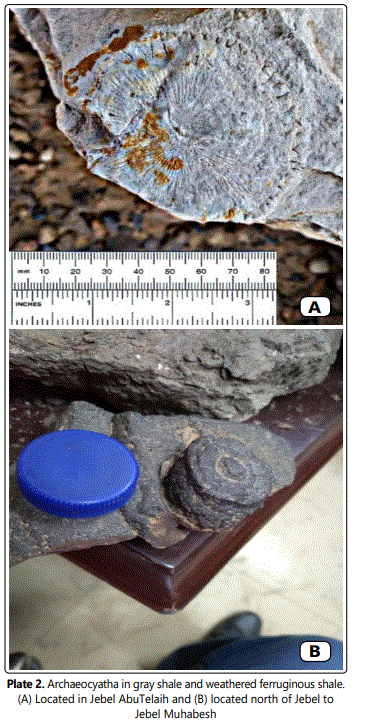
Paleontology of the shale member
Archaeocyatha: Archaeocyatha are an extinct group of sessile marine organisms known only from the Cambrian System, and nearly exclusively from the Lower Cambrian (Rowland, 2001). Archaeocyatha gross morphology ranges from cylindrical to discoid, sometimes with exothecal outgrowths projecting from the outer wall. In most species the maximum diameter of the cup is 1–5 cm; however, some are considerably larger (Rowland, 2001) (Plate 2). Archaeocyatha first appear in the fossil record at the base of the Tommotian Stage of the Lower Cambrian Series; they diversified steadily through the Atdabanian, reaching a peak diversity of about 170 genera in the Botomian Stage (Zhuravlev, 1986a; Debrenne, 1992). Two extinction events, the Sinsk event in the Botomian (Zhuravlev and Debrenne, 1996) and extinction in the Toyonian, took heavy tolls on archaeocyatha diversity, the latter event virtually wiping them out (Debrenne, 1991, 1992; Wood, 1999). Two post-Early Cambrian genera have been described from Antarctica, one from the Middle Cambrian and the other from the Upper Cambrian (Debrenne et al., 1984; Wood et al., 1992a).
2.1.2 Carbonate member: The carbonate member is present interbedded with or overlying the shale member and underlying the siltstone and fine sandstone member. This member consists of limestone, chalk and gypsum. Highly weathered limestone crops out in low hills near Jebel Elbarda and Jebel AbuTelaih and overlies the shale member in Jebel Elbarda and Jebel AbuTelaih. (Fig 4) According to Dunhamʼs (1962) classification of limestone, the limestone in the study area ranged from mudstone to wackestone. The wackestone consists of bioclasts of Gyrophyllites and trilobites. The color ranges from whitish to garish and light brownish. Thin (50cm) layers of chalk and gypsum crop out about 10 km east of Jebel Elbarda and Jebel AbuTelaih and also occur infilling fractures in the shale facies.
Paleontology of the carbonate member
Trilobites: Trilobites range in age from the Cambrian Period approximately 520 Ma and have not been reported from rocks younger than the end of the Permian periods, approximately 250 Ma. (Foote and Sepkoski, 1999). Fragments of unidentifiable trilobites occur in the lower part of Jebel Abu Telaih wackstone.
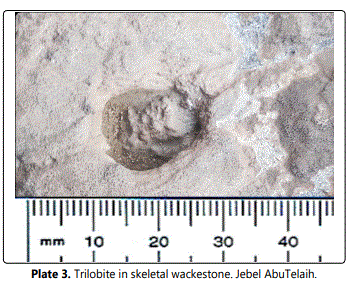
Cyanobacteria (stromatolitic texture)
Stromatolites have been found in wackstone in the lower part of Jebel Abu Telaih (Plate 4). Stromatolites are laminated organo-sedimentary structures formed by microbial trapping and binding of sediment or precipitation of dissolved minerals. Thrombolites and stromatolites are distinct types of microbial (crypt-algal) structures characterized, respectively, by mesoscopic clotted and laminated internal fabrics, Thrombolites occur in the Cambrian and Lower Ordovician sediments (Kennard and James, 1986). The dominance of stromatolites and microbial laminites indicate formation in low salinity brine (60-150 g/l), absence of grazers and burrowers, and sufficient oxygenation in a supratidal and shallow depositional environment (Mandurah and Aref, 2010). Infra-Cambrian to Lower Cambrian stromatolitic limestone is widespread across North Africa and may be an important petroleum source rock (Luning et.al, 2009).
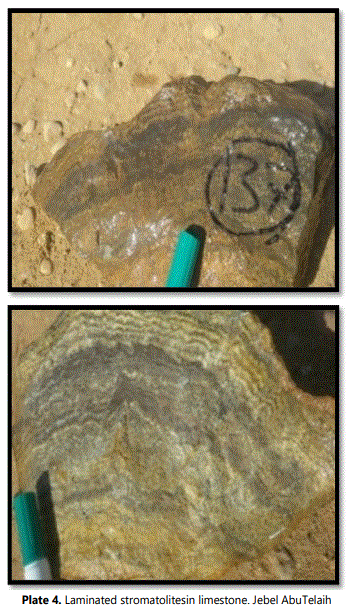
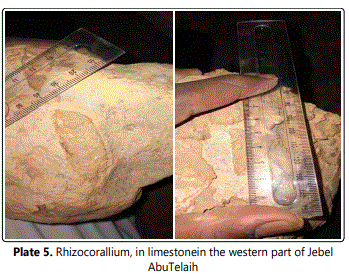
Rhizocorallium: The trace fossil Rhizocorallium is found in Jebel Elbarda and Jebel AbuTelaih (Plate 5). Rhizocorallium occurs in sedimentary rocks throughout the Phanerozoic. On the basis of other paleontological and sedimentological data, Rhozocorallium indicates a shallow marine environment. (Knaust, 2013).
Gyrophyllites: The fossil Gyrophyllites have been found in the southwestern part of the study area (Plate 6). Gyrophyllite Glocker occurs abundantly in deep marine sediments ranging in age from Cambrian to Recent (Strzebonski and Uchman, 2015).
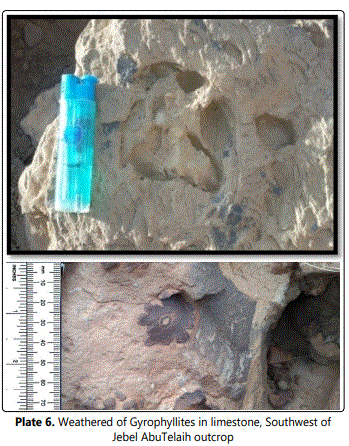
2.1.3. Siltstone with fine Sandstone member (white sand)
The siltstone and fine sandstone member overlies the shale member. The sandstone is well sorted and ranges in color from white to pale yellow. Thickness ranges from 50 cm to 25m. The siltstone and fine sandstone are arranged in upward coarsening sequences (Plate 7 and fig 4).
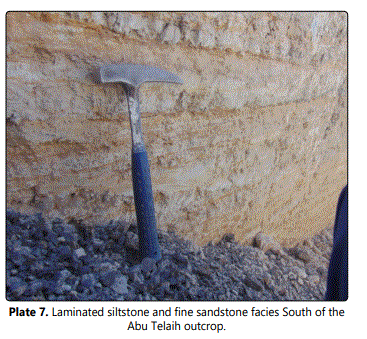
Paleontology in siltstone and sandstone
Thrombolites: Thrombolites are ancient forms of microbial communities that photosynthesize (Kennard and James, 1986). They obtain calcium carbonate from the water to form these structures. Thrombolites were found in the middle of the Abu Telaih and Elbarda areas of the Shendi sub-basin (Plate 8). They differ from stromatolites in the way in which they form. Stromatolites form in layers that are built up on top of each other and also form by a clotting process, and spread out unevenly over time. Thrombolites have an internal clotted texture, while stromatolites have a layered (laminated) internal structure and are formed by blue-green bacteria trapping sediment particles. Thrombolites first appeared in the Neoproterozoic (though there is a possible 1.9 Ga old thrombolite) and occurred throughout the Phanerozoic. They are most commonly found in Cambro-Ordovician strata (Lee.J, 2021). Presumably, because they need sunlight for photosynthesis they indicate a very shallow environment and the presence of it with trilobites in study area indicates a shallow marine environment.
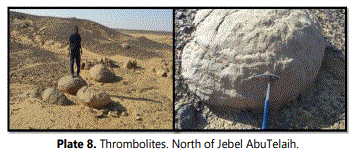
Skolithos: Skolithosis present in the siltstone and fine sandstone (the upper member of Elbarda AbuTelaih formation). This trace fossil occurs as simple, vertical to very slightly inclined tubes (Plate 9). Scolithos indicates a high-energy near shore shallow marine environment (Desjardins et.al, 2010). It occurs throughout the Phanerozoic.
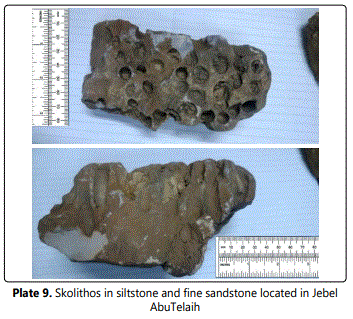
Sedimentary structures in the siltstone and fine sandstone facies
Herringbone cross stratification: Herringbone cross stratification is seen in the siltstone and fine sandstone member (Plate 10). The bidirectional nature of cross-beds is generally taken to indicate tidal currents. It is therefore an indicator of a shallow marine environment (Allen, 1980, Selley, 2000).
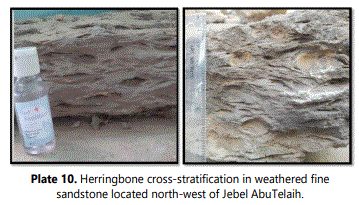
2.1.4 Chert
Chert occurs northeast of the Jebel Elbarda area, North Sudan. Chert is a cryptocrystalline rock made primarily of the mineral quartz (Luedtke, 1992). Chert layers appear above the fine sandstone and carbonate and contain gastropods and conulariides. The chert is composed of sub-rounded boulders, which occur as bed of conglomerate yellowish-brown in color and usually overlying the siltstone and fine sandstone member. The chert is very hard and fossiliferous with abundant gastropods of many sizes (Fig 4).
Paleontology in chert
Conulariides: Conulariides have been found in chert overlying the siltstone and fine sandstone in Jebel Elbarda and Jebel AbuTelaih (Plate 11). The conulariides have an elongated pyramidal exoskeleton made up of rows of calcium phosphate rods. Most were square or rectangular in cross-section with prominent grooves at the corners and fine lamellar structures (Plate 3). Conulariides are an extinct group of benthic marine cnidarians that range in age from Mid–Late Cambrian to Triassic (Babcock, 1987). They lived attached to hard objects by a flexible stalk, and often lived in groups.
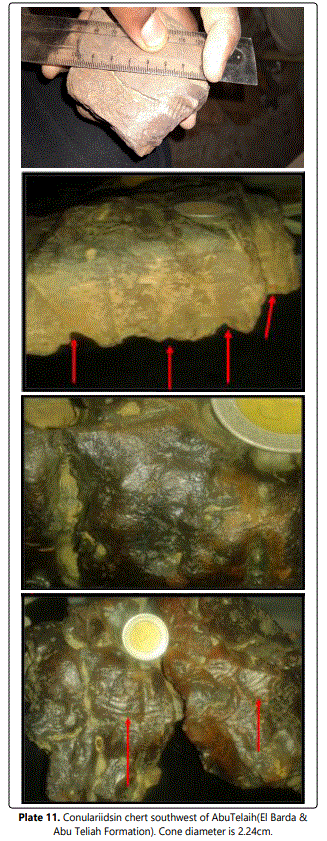
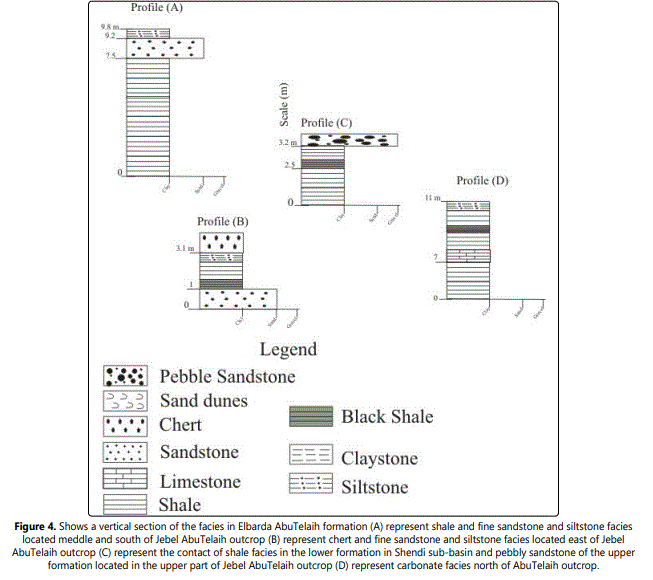
Discussion
The study area was not mapped or studied in detail by the previous workers. It was considering as part of the non-marine Cretaceous Nubian Sandstone Formation (Kheirallah 1978, Awad 1994, Mukhtar 1999). However, a small layer of black shale was reported by group of geologist in the Geological Research Authority of Sudan (GRAS, 2018). This represents the base of the present study.
The GRAS report was the basis of this study, and it led to the discovery of a new formation that differs in characteristics, age, and sedimentary environment from the Nubian Sandstone. It raises the question of the depositional environment of the Hudi chert. (Table 1)

Five new types of fossils have been found in the Elbarda, AbuTelaih Formation including trilobites, which are exclusively marine animals first appearing at the beginning of the Cambrian Period; about 542 million years ago became extinct at the end of the Permian. There are also Archaeocyatha, which are marine organisms that only occur in the Lower Cambrian. The trace fossil Gyrophyllites has also been found. This is believed to be an indicator of a deep marine environment. It is a marine fossil appearing in the Cambrian Period. Conulariides have been found which is an extinct marine group that ranges in age from mid or late Cambrian and to Triassic. And lastly, the trace fossil Rhizocorallium which is found in shallow marine water facies.
Herringbone cross-lamination in the Elbarda and AbuTelaih formation indicates a tidal shallow marine environment.
The fossils of the Elbarda and AbuTelaih Formation indicate an early Paleozoic and specifically Cambrian age according to the fossil Archaeocyatha that became extinct by the middle of the Cambrian (Debrenne, 1991, 1992; Wood, 1999). The deposition of the shallow marine deposits of this formation demonstrates an early Cambrian transgression. This occurred across large areas of Africa (Banks 1973; Hiscott et al. 1984; Matthews and Cowie 1979; Dott et al. 1986; McKie 1990; Hamberg 1991; Desjardins et al. 2010).
The satellite gravity map of Shendi sub-basin (fig 5) shows that it is shallow compared to other basins that located north of central African shear zone (CASZ) in Sudan. According to Selley and van de Spuy (2016) Paleozoic strata are sometimes are preserved in deeper parts of the rifts. This means that the Paleozoic strata were preserved deep in the Shendi sub-basin and then uplifted as a result of a tectonic movement. These Paleozoic strata may be found deep in Atbara basin and other basins in northern CASZ.

Conclusion
The present work on Shendi sub-basin revealed a new sedimentary formation (Elbarda Abu Telaih Formation). This Formation comprises of four sedimentary facies member; shale member, carbonate member, siltstone- fine sandstone member and chert member. New fossils and trace fossil of marine environment have been described in this time from the study area, these fossil with the primary sedimentary structure in study area indicate range of deposition from shallow to deep marine environment.
The study area contains members represent a good source rock for oil with members represents an excellent reservoir.
Acknowledgement
We would like to express our full thanks and gratitude to Geological Research Authority of Sudan, which funded and contributed to the completion of this scientific research. We also continue to thank Professor El Sheikh Muhammad Abdul Rahman, who supported and inspired us to complete this scientific research. We also thank all the people who helped us to complete this scientific research. Finally, we would like to send a special message of thanks, gratitude and appreciation to Professor Richard Selley, who contributed greatly in the revision and correction of this scientific paper.
References
- Allen J. Sand waves: A model of origin and internal structure. Sediment Geol. 1980; 26(4): 281-328. doi: 10.1016/0037-0738(80)90022-6
- Awad M. Stratigraphic, palynological and paleoecological studies on the East- central Sudan (Khartoum and Kosti Basins), late Jurassic to MidTertiary. Selbstverlag Fachbereich Geowissenschaften, Geologie und Paläontologie. 1994.
- Banks N. Tide-dominated offshore sedimentation, Lower Cambrian, north Norway. Wiley. 1973; 20(2): 213-228.
- Debrenne F. Diversification of archaeoyatha. Origin and early evolution of the metazoa. Plenum. New York. 1992.
- Debrenne F. Extinction of the Archaeocyatha. International Journal of Paleobiology. 1991; 5: 95-106.
- Debrenne F, Rozanov A, Webers G. Upper Cambrian Archaeocyatha from Antarctica. Geological Magazine. 1984; 121(4): 291-299.
- Debrenne F, Zhuravelv. Archaeocyatha palaeoecology a Cambrian sessile fauna. Bol Socpaleont Ital spec. 1996; 3: 77-85.
- Desjardins P, Mangano M, Buatois L, Pratt B. Skolithos pipe rock and associated ichnofabrics from the southern Rocky Mountains, Canada: Colonization trends and environmental controls in an early Cambrian sand-sheet complex. Lethaia. 2010; 43(4): 507-528.
- Dott R, Fastovsky D. Sedimentology, stratigraphy, and extinctions during the Cretaceous-Paleogene transition at Bug Creek, Montana. Geology V. 1986; 14(4): 279-282.
- Hiscott R, James N, Pemberton S. Sedimentology and ichnology of the lower cambrian Bradore Formation, Costal Larador: fluvial to shallow marine Transgressive sequence. Bulletin of Canadian Petroleum Geology. 1984.
- Kennard JM, James NP. Thrombolites and stromatolites; two distinct types of microbial structures. P Palaios. 1986; 1(5): 492-503. doi: 10.2307/3514631
- Knaust D. The ichnogenus Rhizocorallium: Classification, trace makers, palaeo environments and evolution. Earth-Science Reviews. 2013; 126: 1-475. doi: 10.1016/j.earscirev.2013.04.007
- Knaust D, Curran H. Skolithos linearis Haldeman, 1840 at its early Cambrian type locality, Chickies Rock, Pennsylvania: Analysis and designation of a neotype. Earth-Science Reviews. 2018; 185: 15-31. doi: 10.1016/j.earscirev.2018.05.009
- Luning S, Kolonic S, Geiger M, Thusu B. Infracambrian hydrocarbon source rock potential and petroleum prospectivity of NW Africa. Geological Society London Special Publications. 2009; 326(1): 157-180. doi: 10.1144/SP326.8
- Lee J. Encyclopedia of Geology. 2nd Edition. Elsevier. 2017; 375-388.
- Luedtke E B. An archaeologistʼs guide to chert and flint. Institute of Archaeology, University of California, Los Angeles, Archaeological Research. 1992.
- Mandurah AA, Mandurah MH. Lithostratigraphy, Facies Interpretation and Depositional Environment of the Lower Miocene Gypsified Stromatolites and Microbial Laminates, Rabigh and Ubhur Areas, Red Sea Coast, Saudi Arabia. Journal of King Abdulaziz University. 2010; 22(1): 117-139. doi: 10.4197/Ear.22-1.7
- Matthews SC, Cowie JW. Early Cambrian transgression. Journal of the Geological Society. 1979; 136(2): 133-135. doi: 10.1144/gsjgs.136.2.0133
- Mckie T. Tidal and storm influenced sedimentation from a Cambrian transgressive passive margin sequence. Journal of the Geological Society. 1990; 147(5): 785.
- Omer MK. The geology of the Nubian Sandstone Formation in Sudan. Geological and Mineral Resources Dept, Ministry of Energy and Mining, Sudan. 1983.
- Rowland. Archaeocyaths-a history of phylogenetic interpretation. Journal of Paleontology. 2001; 75(6): 1065-1078.
- Selley R, Van der Spuy D. The Oil and Gas Basins of Africa. Episodes. 2016; 39: 429-445. doi: 10.18814/epiiugs/2016/v39i2/95786
- Strzebonski P, Uchman A. The trace fossil Gyrophyllites in deep-sea siliciclastic deposits of the Istebna Formation (Upper Cretaceous– Palaeocene) of the Carpathians: An example of biologically controlled distribution. Palaeogeography, Palaeoclimatology, Palaeoecology. 2015; 426: 260-274. doi: 10.1016/j.palaeo.2015.03.004
- Whiteman AJ. The geology of the Sudan republic. Oxford, Clarendon Press. 1971.
- Worrall GA. Features of some semi-arid soils in the district of khartoum), Sudan. European Journal of Soil Science. 1957; 8(2): 193-202.
- Wood R, Zhuravle A, Debrenne F. Functional biology and ecology of Archaeocyatha. Palaios. 1992; 7(2): 131-156.
- Zhuravle A. Evolution of archaeo-cyaths and palaeobiogeography of the Early Cambrian. Geological Magazine. 1986; 123(4): 377-385. doi: 10.1017/s0016756800033471

